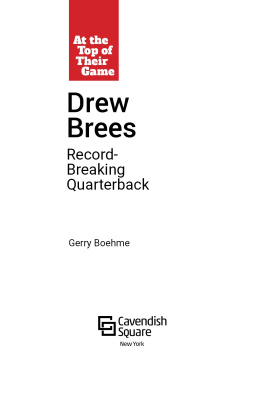
Published in 2018 by Cavendish Square Publishing, LLC
243 5th Avenue, Suite 136, New York, NY 10016
Copyright 2018 by Cavendish Square Publishing, LLC
First Edition
No part of this publication may be reproduced, stored in a retrieval system, or transmitted in any form or by any meanselectronic, mechanical, photocopying, recording, or otherwisewithout the prior permission of the copyright owner. Request for permission should be addressed to Permissions, Cavendish Square Publishing, 243 5th Avenue, Suite 136, New York, NY 10016. Tel (877) 980-4450; fax (877) 980-4454.
Website: cavendishsq.com
This publication represents the opinions and views of the author based on his or her personal experience, knowledge, and research. The information in this book serves as a general guide only.
The author and publisher have used their best efforts in preparing this book and disclaim liability rising directly or indirectly from the use and application of this book.
CPSIA Compliance Information: Batch #CS17CSQ
All websites were available and accurate when this book was sent to press.
Library of Congress Cataloging-in-Publication Data
Names: Boehme, Gerry, author.
Title: Serena Williams : Setting New Standards / Gerry Boehme.
Description: New York : Cavendish Square Publishing, 2018. | Series: At the Top of Their Game | Includes bibliographical references and index.
Identifiers: LCCN 2016050896 (print) | LCCN 2016059257 (ebook) | ISBN 9781502627629 (library bound) | ISBN 9781502627636 (E-book)
Subjects: LCSH: Williams, Serena, 1981---Juvenile literature. | African American women tennis players--Biography--Juvenile literature. | Women tennis players--United States--Biography--Juvenile literature.
Classification: LCC GV994.W55 B64 2018 (print) | LCC GV994.W55 (ebook) | DDC 796.342092 [B] --dc23
LC record available at https://lccn.loc.gov/2016050896 https://lccn.loc.gov/2016050896
Editorial Director: David McNamara
Editor: Fletcher Doyle
Copy Editor: Rebecca Rohan
Associate Art Director: Amy Greenan
Designer: Jessica Nevins
Production Coordinator: Karol Szymczuk
Photo Research: J8 Media
The photographs in this book are used by permission and through the courtesy of: Cover Justin Tallis/ AFP/Getty Images; p. Julian Finney/Getty Images.
Printed in the United States of America
At the Top of Their Game
Contents

Serena Williams displays her 2016 Wimbledon trophy, which was her twenty-second Grand Slam tennis championship.
Introduction
Changing the Face of Tennis
S erena Williams is, simply put, a tennis icon. During the course of her remarkable career, through the 2017 Australian Open, Serena has won an championships and three Olympic gold medals. Serena has also won two Grand Slams in mixed doubles.
When you look more deeply into Serenas life and career, it becomes clear that she has broken the mold of the typical tennis success story. In fact, Serena has taken that mold and shattered it, piece by piece, until it is almost unrecognizable.
Most tennis players are white; Serena is African American. Most players come from higher-income households; the Williams family lived in a poor, crime-ridden neighborhood outside of Los Angeles. Most players receive expert instruction and join the tennis tour at an early age. Serena was trained by her father after he taught himself to play; her father also limited Serenas tournament appearances and made sure she pursued other interests.

Known for her fashions beyond tennis, Serena Williams shows off her latest designs during New York Fashion Week in September 2016.
Few high-ranking players have brothers or sisters who also play tennis at their level. Serenas sister, Venus, stands out as a tennis tennis tour, Serena continued to dominate tennis.
The Serena Williams story extends far beyond tennis, however. She ranks as one of the highest-paid female athletes in the world. Her fashion designs have attracted attention on the tennis court and graced the covers of magazines including Glamour and Vogue. Serena has written books and appeared on numerous television programs, including her own reality show. She has been linked romantically to rappers (Drake, Common), athletes (Amare Stoudemire, Keyshawn Johnson), actors, directors, and even her coach before announcing her engagement to Reddit cofounder Alexis Ohanian in late 2016.
Serena also gives back. Shes built a school in Africa and established a charitable foundation to support education for those in need. In recognition of her work on and off the court, Serena has won many honors and awards, almost too many to count. Time magazine has included her on its list of the one hundred most influential people in the worldtwice!
In a movie she made about Serena and her sister Venus, director Maiken Baird said, The story of the Williams sisters is the ultimate American story two African American sisters who come from the They become number one and number two in the world.
In 2006, Serena told Tennis magazine, Theyll always remember Venus and me for starting a whole new , the return, the fashion. We changed the whole game.
Serena Williams has changed the face of tennis itself.

Serena Williams (left) learned to play facing older sister Venus (right) on the public courts in poor Compton, California.
Chapter 1
The Seeds of Stardom
S erena Williams was raised in the city of Compton, located in south central Los Angeles. Compton was, and still is, a rough area, haunted by poverty, drugs, and gangs. In 2005, a national study ranked all US cities based on crime; Compton finished fourth in the country.
Serenas father, Richard, grew up poor in a primarily African American neighborhood in Shreveport, Louisiana. Richards mother picked cotton for a living, and she raised him with four sisters after his father abandoned the family. Richard experienced the full effects of racism while growing up in the 1940s and 1950s, a time when the Southern states were . He was called terrible names, had to ride in the back of buses, could not eat in certain restaurants, and had to use public facilities reserved for blacks only. Richards mother taught him to believe in himself despite these difficult experiences.
In his book Black and White: The Way I See It, Richard Williams wrote, It took a long time to understand what [my mother] was trying to teach methat every person had the responsibility to make something of himself no matter how people saw him. What you find in life, you deal with.
In the 1970s, Richard moved to Los Angeles. There he met and fell in love with Oracene Price, a nurse with three daughters from a previous relationship. Richard and Oracene married and, shortly after daughter Venus was born in 1980, the family moved to Oracenes hometown of Saginaw, Michigan. Serena Williams was born there in 1981.
In April 1983, the family moved to Compton because, Richard said, he wanted his daughters to grow up in a difficult environment to help them prepare for the hardships they would face in life. He hoped it would help them appreciate what they would later accomplish for themselves.















